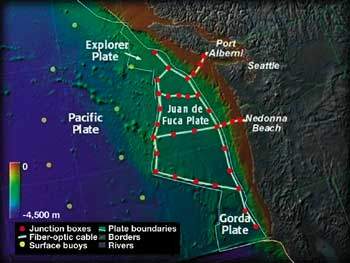What's happening in exploration
Quake shakes understanding of seafloor vents: Project NEPTUNE"The damn thing broke." That’s what Paul Johnson and Mike Hutnak thought. The seafloor geologists were looking at 10 months of well-behaved temperature data that suddenly went bonkers; it turned out that their temperature sensors were working fine. Johnson, a University of Washington oceanographer, was lead author of a paper that discussed the observations in the Sept. 14 issue of Nature. The oceanographers discovered that a small (magnitude 4.3) tectonic earthquake had occurred on the Endeavour Segment of the Juan de Fuca Ridge, about 180 mi off the Washington state coast. NOAA scientists recorded the June 8, 1999, earthquake using the Navy’s SOSUS array. Four to 11 days later, seafloor instruments at hydrothermal fields 4.7 mi away began recording substantially warmer water, flowing at 10 times the normal rate and in an unexpected pulsing pattern. The erratic temperature and flow data have scientists questioning long-held assumptions about fluid flow in oceanic crust. The Endeavour Segment has several large, stable hydrothermal fields and was assumed to be "quiescent." Most areas are diffuse water flows only 4° to 10°C warmer than the surrounding ocean. However, a small number of vents produced water as hot as 350°C. "Scientists have prejudices just like everyone else, and we had this mental view in our heads that things on the seafloor just aren’t supposed to change like that. We thought, well, we did something wrong; our instrument broke," Johnson said. Conventional models assume that fluid flow is stable and relatively steady for long periods. It was a surprise that hydrothermal vents nearly five miles from the earthquake’s epicenter reacted in such complex ways. "It could be that the fluids over hundreds of miles of mid-ocean ridges are influenced by even moderate quakes," Johnson says. Observations of hydrothermal venting on the Juan de Fuca Ridge began in 1980 and have continued every year since. A proposal to create an underwater observatory, called project NEPTUNE, seems certain to move forward (www.neptune.washington.edu). The goal of project NEPTUNE is to establish a plate-scale submarine network of remote, interactive natural labs that are spatially associated with the Juan de Fuca tectonic plate. NEPTUNE’s 2,000 mi of fiber-optic / power cables will provide power and communications to scientific instruments (temperature, flow, seismic, etc.) and allow real-time, 4-D experiments designed to quantify oceanographic and plate-related processes.
Remote experimental sites will be connected with land-based research labs and classrooms to provide real-time data and imagery to shore-based Internet sites, including interactive control over onsite robotic vehicles. It is hoped that thorough, 4-D examination of at least one plate / mesoscale system will generate major new insights into all such systems. NEPTUNE may also serve as a unique testbed for sensor and robotic systems in other oceans. The NEPTUNE network is expected to be operational by 2005 and will cost between $100 million and $150 million. It’s odd that no one from the oil patch is sponsoring this, given the obvious extension of applications (see figure). BP strikes big. This was the largest discovery – and BP’s second this year – made offshore Trinidad and Tobago in a series of successful strikes. The discovery well, located 35 mi east of Galeota Point in Red Mango field, indicates a structure containing 3 Tcfg and 90 million bbl of condensate, but appraisal wells will be needed to confirm field size. Chevron discovery. Chevron made another Angolan oil discovery in deepwater Block 14, the sixth major discovery by Chevron and its partners in Block 14 since 1996. The Lobito-1X discovery well was drilled in August in 1,340-ft water and tested in early September. A drillstem test flowed 10,200 bpd of 35°API-gravity oil. "We intend to continue our aggressive approach of quickly moving Block 14 discoveries into production. This commitment is reflected in Chevron and partners’ investment plans for Angola, which total about $6 billion over the next five years," said Peter Robertson, president of Chevron Overseas Petroleum Inc. This latest discovery is located near four previously discovered fields: Kuito (1997), Benguela (1998), Belize (1998) and Tomboco (2000). Kuito field – Angola’s first deepwater development – began production in December 1999 and currently produces more than 70,000 bopd, with further development drilling ongoing. Correction. In the August 2000 issue of
World Oil, we incorrectly named TotalFinaElf as operator of Kuito field. The correct Kuito field
(Block 14) partners are: Chevron (operator, 31% interest), TotalFinaElf (20%), SONANGOL (20%), Agip (20%) and
Petrogal (9%).
|
- Applying ultra-deep LWD resistivity technology successfully in a SAGD operation (May 2019)
- Adoption of wireless intelligent completions advances (May 2019)
- Majors double down as takeaway crunch eases (April 2019)
- What’s new in well logging and formation evaluation (April 2019)
- Qualification of a 20,000-psi subsea BOP: A collaborative approach (February 2019)
- ConocoPhillips’ Greg Leveille sees rapid trajectory of technical advancement continuing (February 2019)




